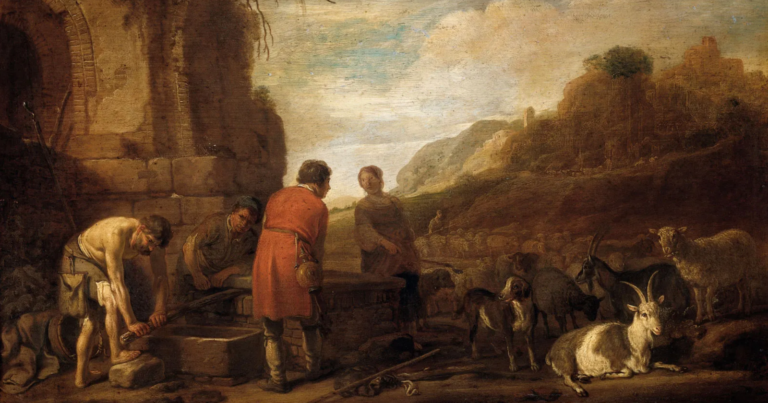“For we live by faith, not by sight.”
2 Corinthians 5:7
The Second Letter of St. Paul to the Corinthians is a timeless piece of Scripture that continues to hold immense relevance and importance in today’s world.
This epistle, penned by St. Paul, is not simply a historical text but a wellspring of divine wisdom applicable to our lives now.
Delving into this letter, you’ll discover how its teachings can guide our actions and shape our perspectives even in the present day. It offers invaluable insights into faith, suffering, reconciliation, and the power of God’s grace.
Let’s explore the profound significance of this often-overlooked biblical letter and learn why it remains a crucial part of Christian teachings.
Why did Paul write the Second Corinthians?
The Second Letter of St. Paul to the Corinthians is a profound piece of biblical scripture that offers a wealth of spiritual teachings.
At its core, this letter focuses on the themes of faith, suffering, reconciliation, and grace.
St. Paul constructs the letter in a manner that provides a personal glimpse into his thoughts and experiences, making it a deeply emotive and relatable text.
He discusses his struggles and hardships, ultimately revealing how they served to strengthen his faith and reliance on God’s grace.
St. Paul wrote the Second Letter to the Corinthians for a few big reasons.
First off, he wanted to connect again after his first letter, which had some tough love. This time around, he aimed to mend fences, showing his deep care and concern for the Corinthian believers. Why?
Because he heard about the challenges they faced and wanted to offer comfort, encouragement, and a bit of correction where needed.
Besides, Paul felt the need to defend his apostleship. Some folks in Corinth started doubting his credentials and motives. So, he laid out his case, not to boast, but to reassure them of his genuine commitment to Christ and them.
Lastly, he talked a lot about reconciliation—how God reconciled the world to Himself through Jesus and how we’re called to live out that reconciliation.
Key themes from the second letter of Paul to the Corinthians
1) Triumph in suffering
Suffering and triumph seem like total opposites, right?
But in his second letter to the Corinthians, Paul flips the script on what it means to suffer.
He shares, “For just as the sufferings of Christ overflow to us, so also our consolation overflows through Christ” (1:5).
This means that, yes, following Jesus might lead to tough times, but it also brings an overwhelming amount of comfort and strength that can only come from Him.
Paul’s own story is a testament to this.
He faced hardships we can hardly imagine—beatings, shipwrecks, you name it. Yet, he saw these trials not as defeats but as victories.
Why?
Because they were opportunities to experience God’s power and presence in the rawest form.
It’s counterintuitive, but maybe our darkest moments are when God’s light shines the brightest in our lives.
Let’s face it, nobody wants to go through hard times, but Paul reassures us that suffering isn’t the end of the story—it’s just the setting for a greater triumph.
2) Treasure in jars of clay
Now, this is a powerful image:
“But we have this treasure in jars of clay, to show that this all-surpassing power is from God and not from us” (4:7).
Picture an ordinary, fragile clay pot. Doesn’t look like much, right?
But imagine it holding a treasure.
Paul uses this imagery to describe us—yes, we’re fragile and crack easily, but we hold within us the incredible treasure of God’s Spirit.
This is raw and honest: we’re not superhumans. We get tired, scared, and broken.
Yet, despite our frailty, we carry within us the divine, the eternal, the powerful.
It’s a bit mind-blowing when you think about it.
The very presence of God chooses to dwell in our imperfect, easily shattered lives. This isn’t just about God working through our weaknesses — it’s about Him transforming our entire existence into something precious.
So, maybe the next time we feel too broken or inadequate, we should remember this: it’s precisely in our “cracked” moments that God’s light shines out of us, revealing the treasure we carry.
3) The power of weakness
Paradoxically, St. Paul highlights that our weaknesses can be sources of strength.
He suggests that when we acknowledge our weaknesses, we open ourselves to God’s grace and strength.
Think about it: we often see our weaknesses as failures, something to hide or fix.
However, Paul flips this on its head in 2 Corinthians. He talks about boasting about his weaknesses, not his strengths.
The thing is that when we’re weak, that’s when God’s strength shines the brightest in us.
“My grace is sufficient for you, for my power is made perfect in weakness,” God tells Paul (2 Corinthians 12:9). It’s a radical idea, but it makes sense.
In our most vulnerable moments, we lean more on God, and His power takes center stage. It’s not just our capabilities but what God can do through us.
4) Genuine love
What is genuine love?
St. Paul poses a question that makes us reflect on our understanding of love.
He describes it as patient, kind, not envious, or boastful, always protective, trusting, hopeful, and enduring.
Therefore, it challenges us to examine our actions and attitudes toward others.
Paul urges the Corinthians to open their hearts wide, not just to him but to each other (2 Corinthians 6:11-13).
He talks about the importance of forgiving others to prevent Satan from taking advantage of us Genuine love, according to Paul, means seeing beyond our own needs and desires, and it involves a lot of giving without expecting anything in return.
5) The holy spirit as a pledge
We all know that faith can be hard. Believing in what we can’t see, hoping for what feels far off.
But here’s where it gets real: Paul talks about the Holy Spirit as a “pledge,” a down payment guaranteeing what’s to come (2 Corinthians 1:22, 5:5).
It’s like God’s promise, written in our hearts, that there’s more to this life than what we see.
The Holy Spirit working in us is proof that God’s not done yet. He’s started something good, and He’ll finish it.
So, other than waiting for heaven, we should try to experience bits of heaven here and now, through the Holy Spirit’s power and presence in our lives.
6) Role of reconciliation
Lastly, the letter underscores the importance of reconciliation in the Christian community.
Reconciliation is not just making up after a fight.
In the second letter, Paul tasks about a complete overhaul of relationships—between us and God, and between each other.
“God was reconciling the world to himself in Christ, not counting people’s sins against them… We are therefore Christ’s ambassadors, as though God were making his appeal through us” (2 Corinthians 5:19-20).
It’s like God is inviting us to be part of His team, helping to mend broken relationships and bring people back to Him.
This isn’t just about saying sorry — it’s about changing lives and communities. Maybe, it’s seeing others through God’s eyes, focusing on restoration rather than fault-finding.
In either case, St. Paul urges believers to forgive one another and mend divisions within the community. This straightforward message teaches us about unity and harmony as central tenets of Christian living.
Why forgive?
“Anyone whom you forgive, I also forgive. Indeed, what I have forgiven, if I have forgiven anything, has been for your sake in the presence of Christ.”
2 Corinthians 2:10
As you probably already noticed, St. Paul’s Second Letter to the Corinthians places a strong emphasis on the act of forgiveness.
It is presented as a vital aspect of Christian living, serving as a bridge to reconciliation and unity within the community.
What does Paul aim to teach us about forgiveness?
Well, he aims to inspire us to let go of resentment and embrace compassion. What’s more, he presents forgiveness not merely as an obligation, but as a liberating act that reflects the grace and mercy of Christ.
In this context, forgiveness is seen as a means of healing divisions, fostering peace, and promoting a stronger sense of community among believers.
It serves as a reminder of the transformative power of love and grace in our lives.
Comparison of 1st and 2nd Corinthians
Paul wrote his First Letter to the Corinthians around AD 53-54 from Ephesus during his third missionary journey.
It was a time when the Corinthian church was grappling with issues of division, immorality, and questions about Christian doctrine and practice.
This letter was in response to reports Paul had received about the community’s struggles and questions they had directly posed to him.
On the other hand, the Second Letter to the Corinthians was penned shortly after the first, around AD 55-56. It was also likely from Macedonia, after Paul had left Ephesus.
Between the two letters, Paul had made a “painful visit” to Corinth (2 Corinthians 2:1) and had sent a “severe letter” (2 Corinthians 2:4) to Titus to address ongoing issues.
Given the different contexts and purposes behind Paul’s letters to the Corinthians, here are a few key points of comparison:
1) Timing and context:
- 1 Corinthians was written around AD 53-54 from Ephesus.
- 2 Corinthians followed around AD 55-56 from Macedonia.
2) Response to community issues
- 1 Corinthians tackles divisions, immorality, and doctrinal confusion based on reports and inquiries to Paul.
- 2 Corinthians deals with the aftermath of Paul’s disciplinary actions, focusing on reconciliation, defense of his apostleship, and the emotional and spiritual state of the Corinthian church post-correction.
3) Tone and approach:
- The tone of 1 Corinthians is more direct and corrective, aiming to address and resolve specific issues.
- 2 Corinthians is more personal and conciliatory, reflecting Paul’s relief and gratitude for the Corinthians’ repentance.
4) Themes and content:
- 1 Corinthians emphasizes practical and doctrinal guidance, covering a wide range of church life and Christian practice.
- 2 Corinthians explores the themes of suffering, strength in weakness, the nature of true apostleship, and the ministry of reconciliation in greater depth.
Moving forward with Paul’s wisdom
All in all, the Second Letter of St. Paul to the Corinthians offers timeless wisdom that can guide our spiritual growth and daily living.
Its teachings on faith, suffering, grace, and forgiveness provide practical insights that can transform our perspectives and actions.
To take the next steps in your learning journey, consider reflecting on these themes in your personal prayer time.
- Explore how they resonate with your own experiences and challenges.
- Ask yourself how you can apply St. Paul’s teachings to your own life.
Above all, seek to live out these teachings in your daily interactions and decisions. The true value of this epistle lies not just in understanding its content, but in allowing it to shape our lives.











